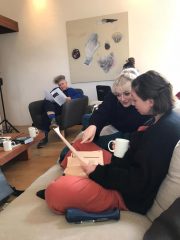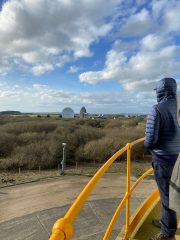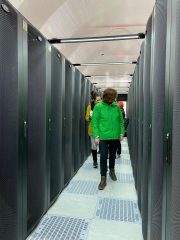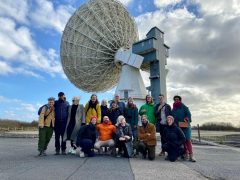
Report 2022
This account of the sixth Cornwall Workshop, held at Kestle Barton in March 2022, was compiled by three of the participants – artist Sam Bestwick (text in black), curator Céline Holman (text in green), and artist SHARP (text in purple). Sam maps the day-by-day structure of the week, Céline describes particular episodes, and the narrative is book-ended by SHARP’s recollections of thoughts and feelings – on arriving at Kestle Barton and at the end of the workshop week.
THE JOURNEY
Where am I going?
Driving to Kestle Barton, down winding lanes with hedges blocking my view of the horizon, I was starting to feel a bit anxious about where I was going. Was I going in the right direction?
A metaphor you could say.
SPACE
I was the first to arrive. The place seemed vast, with different outbuildings. It’s set between fields and woodland and Daphne du Maurier’s Frenchman’s creek. I walked around a bit, wondering where everyone was, a bit nervous to find myself alone in a new place in the middle of nowhere. I’ve seen far too many horror films. But then I was greeted by a friendly face: ‘Hello, are you here for the workshop?’ ‘Yes’, I replied ‘my name is SHARP’.
I was shown to my room in the old farmhouse. It was small and cosy, with a double bed and a window with flower-patterned curtains overlooking a garden. I opened the window and bird song echoed in. Yes, it was this picturesque – and I loved it. It was clear this residency was going to be something special, set in this beautiful place. I lay down on the bed and relaxed into the place, all apprehension gone.
SIGNALS
As others arrived and rooms were filling, we all started to meet and introduce ourselves. It instantly felt like a group of friends together. At the end of the weekend Elizabeth Price shared a comment about a culture of support and trust we established as a group and I feel this was naturally established from day one. Yes, we had our differences and the weeklong workshop opened conversations and debate, but this was also what it was about – challenging ourselves – and the workshop was a challenge at times. Don’t think you can come here with pre-set ideas; the workshop makes you think – it asks questions. With artists’ talks, field trips, walks, lectures, the week is packed with things to do. If you want to come just for some quiet space and time for your own practice this isn’t it.
The Workshop began with us all converging at Kestle Barton on Friday evening, settling in and getting to know each other over a group dinner.
Gathering around the table to share food and drink is central to the experience. How lucky we are to have someone cook for us, nourishing us with healthy, warming, delicious meals every day! I feel so privileged. All sat at one big table, getting to know each other, sharing stories and ideas, we talk about the food – it becomes central to our lives, as it should be.

Saturday: We took it in turns to introduce ourselves briefly to the entire group, describing our individual practices whilst presenting a single piece of work for discussion. This experience turned out to be a great way to get to know each other, whilst also serving as a catalyst for conversations throughout the week. These presentations were broken up with walks around Kestle Barton and the nearby Frenchman’s Creek.
There’s a nervousness in each one of us. Who will go first? Dean bravely volunteers. Opening up like this in front of strangers feels like being at school, college or university again. But in the shared nerves we all acknowledge our own vulnerability. No-one is here to judge. The mix of presentations keeps the day alive – fatherhood, performed poetry, accounts of the supernatural, living under Section 28 – each story offers a snippet of the individuals we are going to share the week with.
Sunday: A slow start, before what was scheduled to be a busy afternoon and evening ahead.
A small group of us headed down to the river for a morning swim. The wooded valley is lush and damp, all moss and mud. Susie led us across the creek to a small outcrop of grass, from which we could dip straight into the deep water. It’s a wonderful spot, with overhanging trees and a small floating pontoon. The cold sharp water was an instant reset, a call to rethink, repose. I hadn’t been in the water since last November and it felt as good as anything. Tingling limbs, slapped skin, short gasps. We climbed our way back to Kestle Barton to grab some soup and head out to CAST for the afternoon.
In this period of calm, Elizabeth Price took the opportunity to explain the brief for the week – a small project/task specifically designed to take us out of our comfort zones. Arriving at CAST that afternoon, we started off by watching her film USER GROUP DISCO, installed in CAST’s black box screening space.
Elizabeth’s films are visceral and electric, the best start to an afternoon of reading and discussion. In a studio space upstairs, we were joined by participants from previous Cornwall Workshops. In this session we read various texts selected by Elizabeth and the guest artists: Katrina Palmer’s ‘Now Stone’, Chrystos’ No Rock Scorns Me As Whore, extracts from Elizabeth Price’s ‘West Hinder’ narration, Raymond Roussel’s ‘Locus Solus’ and Laura Grace Ford’s ‘Sky Blue Connection’. We returned to the screening space for Elizabeth’s brilliant artist talk, where she spoke about the ideas behind her practice, focusing on her most recent work. The evening concluded with a large group dinner in the Café at CAST, including many participants from previous workshops. Then back on the minibus to Kestle Barton.

Monday: The day began with a presentation by one of the guest artists, Simon Bedwell, in which he discussed his approach to collaboration, drawing upon his experience as part of the former BANK collective, whilst also taking time to discuss his more recent work. That afternoon we went for a group walk to Manaccan and round Dennis Head, eventually circling back to Kestle Barton for dinner.
Tuesday: In the morning all of us gathered in the old apple store space at Kestle Barton for an online talk by Laura Grace Ford. She had produced a piece of writing, ‘Notes for a Spectral Drift’, especially for the workshop. We read it as a group that evening.
Laura’s practice combines writing, sketching, zines. She conjures up lost voices and memories and seeks to bring to life ‘residues’ of the past in places that have been forgotten, left to decay. She explained how she goes on dérives, walking, often with other people, sketching, looking, annotating, observing; creating a psychic space where unrealised futures can manifest and alternative narratives can be imagined. Through absence something can be captured, a spectral presence of a potential future that haunts architecture and landscape. She spoke of ‘channelling the shards of time that are embedded in places.’ The talk completely captured me and I wanted to re-read ‘Notes for a Spectral Drift’ again.
That evening, after a lovely walk by the river and a swim at Helford, we all met in the farmhouse before dinner to read the text together. In front of a warm fire, we all sat with laptops, print-outs and phones and took it in turns to read paragraphs. This was an incredible moment for us, a group of people who had only just met a few days ago. One after the other, we picked up seamlessly from where the other had stopped, words naturally flowing from one timbre of voice to the next. It was magical. The text is astonishing, an alternative portrait of Cornwall and Redruth. Laura’s ability to make somewhere so familiar, so vivid. We all had so many questions: When was she last in Cornwall? Had she made up the main character? Was it mostly done by research, or through lived experience?

Wednesday: An early start to what was going to be a busy day. We were due at Kresen Kernow in Redruth that morning, though on the way we took a slight diversion to the Long Stone on Prospidnick Hill near Helston, one of Cornwall’s many Neolithic standing stones. At Kresen Kernow, Cornwall’s archive centre, we spent the morning exploring a small collection of the material accessible there.
Elizabeth Price and Joseph Noonan Ganley had chosen some materials from Kresen Kernow’s archive. From nineteenth-century death sentence notices to recent queer zines, the choices were a real mélange of insights into Cornish history and identity, as multiple as the choices of materials. I was especially struck by photographs of Gwennap Pit being used as a place of congregation: hordes of people in their Sunday best, sitting down in an ancient circular grassed amphitheatre, listening to sermons and preaching.
That afternoon we took a trip to King Edward mine, just outside Camborne. Here, we were given a brief introduction to the site and its history before having a look round the mine’s workshop.
I spent way too much time playing the ‘Holman’ bingo. Holman is my married name. I’m not from Cornwall, although I’ve lived here eighteen years, and somehow I find it difficult to describe myself as Cornish. However, discovering there is something called a ‘Holman Slime Table’ makes me feel that maybe I do have a right to this place after all!
That evening we went to the Woodlane Lecture Theatre at Falmouth School of Art, where Elizabeth was giving an artist’s talk. Then to CAST for dinner
Thursday: In the morning there was an artist’s talk by Katrina Palmer.
Katrina’s practice uses prose, language and narrative as sculptural form. She presented on Zoom, unable to join us in person, and introduced her presentation as a performance. She described the detachment she felt looking at past work, how she felt an act of distancing, fragmentation, dream-state. As a curator, this idea stayed with me for a while.
Following this we took a trip to Goonhilly Earth Station where we were given a guided tour round the facility as well going into the interior of one of the station’s oldest satellite dishes.

We were welcomed by Ian Jones, CEO of Goonhilly Earth Station Ltd, the satellite communication company took over from BT in the mid 2010s. The site is full of layered history. Named after the surrounding downs, Goonhilly Earth Station is home to ancient standing stones and burial grounds; twenty-first-century communications meet pagan tradition.
The team was incredibly welcoming and eager to share their enthusiasm for space engineering and satellite communications. It felt very special for a group of artists and writers to be welcomed in this way. We were given a tour of the grounds and were invited to go inside one of the older structures, Goonhilly 3 or Guinevere (the original dishes, erected in the 1960s, have names drawn from Arthurian legend). Resembling a lighthouse, the antenna and its dish seem straight out of science fiction. The interior is full of dials, diagrams, wires and humming noises. There’s something quite unreal about these gigantic and now ancient-feeling bits of tech. Ian also took us to see their data centre, with columns of computers in vertical black boxes making low level white noise in unison.

There’s an abundance of void on the site: huge buildings with only a fraction of the space now required for the current technology. Everything has shrunk in size over the years and there are numerous disused and almost empty rooms housing stacks of outdated technology. A perfect set for a zombie movie.
That afternoon we had a talk by the artist Joseph Noonan Ganley, who had travelled down from London to stay for the last few days of the workshop. In the evening we had our last group dinner.
Friday: After packing up and leaving Kestle Barton, we travelled to CAST once more to share the outcomes of our brief. We had a soup lunch and said our goodbyes before leaving for the station, where we each headed in our separate directions.

END MATTER
It’s the little things
In-between
Along the Journey
The conversations
The gorgeous food
The walks
The laughter
The dancing
The singing
The feeling sick in the back of the van
The swimming in the creek
The warmth of new friendships
The challenges of new opinions
The openness
A door that’s not locked
A togetherness
Sharing
Moments
The little things
The differences
The connections
With thanks to SHARP, Sam Bestwick and Céline Holman.
